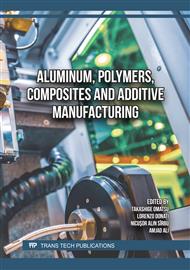p.35
p.51
p.63
p.71
p.77
p.89
p.95
p.103
p.109
Investigating the Debonding of Aluminum and Carbon Fiber Reinforced Polymer (Al-CFRP) in Type-III Filament-Wound Composite Vessels Subject to Temperature Variations
Abstract:
In this work, nitrogen gas inside cooling experiments of CFRP and GFRP wound composite pressure vessels were carried out. Teflon sheet inserted axisymmetric artificial defects in Al-CFRP interface and without any defect composite vessels were manufactured. Thermocouples were positioned at various points on the exterior of the GFRP hoop surface to track the extent of temperature changes during the cooling test. Destructive cutting and optical microscopy were used to observe the post-cooling Al-CFRP interface morphology at defective locations of composite vessel specimens, revealing the propagation of Al-CFRP interface delamination. Furthermore, a comparative analysis was carried out on an additional set of composite vessels under identical cooling conditions, and a burst test was performed to assess the impact of Al-CFRP debonding on the magnitude of burst pressure. Interestingly, the results indicated no significant difference in the burst pressure between vessels with and without the pre-introduced defect post-cooling.
Info:
Periodical:
Pages:
95-102
Citation:
Online since:
October 2024
Price:
Сopyright:
© 2024 Trans Tech Publications Ltd. All Rights Reserved
Share:
Citation:



